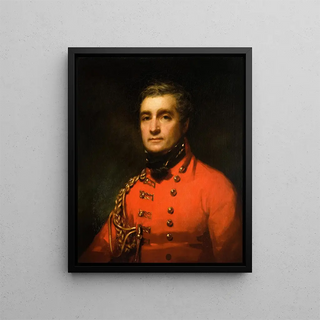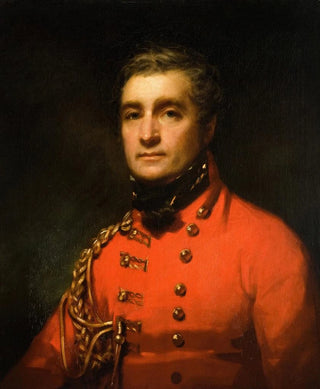Art print | Portrait of General Henry Wynyard - Sir Henry Raeburn


View from behind

Frame (optional)
In the rich and captivating world of 18th-century English painting, the "Portrait of General Henry Wynyard" by Sir Henry Raeburn stands out for its psychological depth and timeless elegance. This artwork, a true masterpiece of portraiture, invites us to delve into the soul of a man while offering a glimpse of the Victorian era. Through General Wynyard's piercing gaze, the viewer is transported to a suspended moment where history and art meet, revealing the hidden stories behind each brushstroke. This art print of the portrait, faithful to the original, allows appreciation of Raeburn's virtuosity while adding a touch of nobility to any living space.
Style and uniqueness of the work
Raeburn's style is characterized by an exceptional mastery of light and shadow, as well as meticulous attention to detail. In this portrait, General Wynyard is depicted with remarkable presence, dressed in a military uniform that emphasizes his status and authority. The color palette chosen by the artist, oscillating between warm and cool tones, creates an atmosphere that is both solemn and lively. The features of the general, carefully rendered, testify to a deep humanity and a certain introspection, captivating the viewer's gaze. Raeburn manages to capture not only the physical appearance of his subject but also his character, making this work a perfect example of the portrait's ability to transcend mere representation.
The artist and his influence
Sir Henry Raeburn, an iconic figure of Scottish painting, established himself as one of the greatest portraitists of his time. His innovative approach and distinctive style marked an era when the art of portraiture was evolving rapidly. Raeburn was influenced by the great masters of the Renaissance, while developing a unique aesthetic that combines realism and idealization. His impact on the Scottish art scene is undeniable, and his works continue to inspire many contemporary artists. As a member of the Royal Academy, he contributed to the recognition of Scottish art.

Matte finish

View from behind

Frame (optional)
In the rich and captivating world of 18th-century English painting, the "Portrait of General Henry Wynyard" by Sir Henry Raeburn stands out for its psychological depth and timeless elegance. This artwork, a true masterpiece of portraiture, invites us to delve into the soul of a man while offering a glimpse of the Victorian era. Through General Wynyard's piercing gaze, the viewer is transported to a suspended moment where history and art meet, revealing the hidden stories behind each brushstroke. This art print of the portrait, faithful to the original, allows appreciation of Raeburn's virtuosity while adding a touch of nobility to any living space.
Style and uniqueness of the work
Raeburn's style is characterized by an exceptional mastery of light and shadow, as well as meticulous attention to detail. In this portrait, General Wynyard is depicted with remarkable presence, dressed in a military uniform that emphasizes his status and authority. The color palette chosen by the artist, oscillating between warm and cool tones, creates an atmosphere that is both solemn and lively. The features of the general, carefully rendered, testify to a deep humanity and a certain introspection, captivating the viewer's gaze. Raeburn manages to capture not only the physical appearance of his subject but also his character, making this work a perfect example of the portrait's ability to transcend mere representation.
The artist and his influence
Sir Henry Raeburn, an iconic figure of Scottish painting, established himself as one of the greatest portraitists of his time. His innovative approach and distinctive style marked an era when the art of portraiture was evolving rapidly. Raeburn was influenced by the great masters of the Renaissance, while developing a unique aesthetic that combines realism and idealization. His impact on the Scottish art scene is undeniable, and his works continue to inspire many contemporary artists. As a member of the Royal Academy, he contributed to the recognition of Scottish art.






